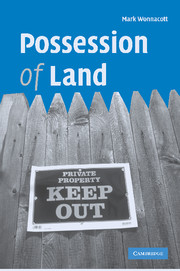Book contents
- Frontmatter
- Contents
- Preface and acknowledgments
- Table of cases
- Table of statutes
- Table of statutory instruments
- 1 Meaning of possession
- 2 Protection of possession
- 3 Possession, title and freehold land
- 4 Leases and licences
- 5 Mortgages and charges
- 6 Equity and trusts
- 7 Birth and death, dissolution and insolvency
- 8 Adverse possession and prescription
- 9 Possession judgments
- 10 Summary and conclusions
- Index
8 - Adverse possession and prescription
Published online by Cambridge University Press: 13 August 2009
- Frontmatter
- Contents
- Preface and acknowledgments
- Table of cases
- Table of statutes
- Table of statutory instruments
- 1 Meaning of possession
- 2 Protection of possession
- 3 Possession, title and freehold land
- 4 Leases and licences
- 5 Mortgages and charges
- 6 Equity and trusts
- 7 Birth and death, dissolution and insolvency
- 8 Adverse possession and prescription
- 9 Possession judgments
- 10 Summary and conclusions
- Index
Summary
Introduction
Adverse possession and prescription are both processes by which rights in land are barred by lapse of time.
The right to recover possession of an estate is barred by adverse possession.
The right to use and enjoy an estate in a particular way is barred by prescription. Prescription bars the estate owner's right to complain about trespasses and nuisances, and also bars the right to exploit the estate in particular ways. But it bars only those rights which a predecessor could have granted away from the estate as an incorporeal hereditament.
So the difference, in effect, between the two is that adverse possession is the means by which the entire ownership of an estate is extinguished whereas prescription is the means by which lesser rights are acquired against it, without affecting the ownership of the estate itself.
This chapter explores the similarities and differences in these processes, and explains the reasons for them.
Conceptual similarities and differences
English land law, as we have already seen, is built on the rather shaky foundation that William the Conqueror extinguished all subsisting estates and interests in 1066, and carved the whole country up afresh. The buttress between this fiction and the firm ground of reality is the rule that the legitimate enjoyment of any estate or interest is presumptively proved by prior enjoyment.
- Type
- Chapter
- Information
- Possession of Land , pp. 125 - 144Publisher: Cambridge University PressPrint publication year: 2006



